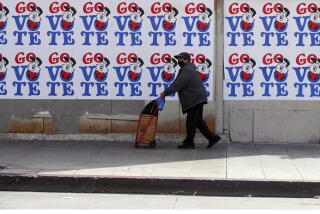November’s big ballot probably won’t be downsized by California’s new election law
In a state where direct democracy is considered a birthright, activists have often bypassed legislators and asked voters to write laws at the ballot box.
But one year after the enactment of what was hailed as a major electoral reform to encourage compromise between the two lawmaking processes, there’s still skepticism of working inside the world of Sacramento politics.
Even from some politicians who work there.
“We don’t have the time, in California’s future, to water down critical legislation,” said Assemblyman Roger Hernandez (D-West Covina) as he joined organized labor groups last week in submitting voter signatures for a November ballot initiative to raise the state’s minimum wage.
The wage measure, plus a handful of others likely to secure a spot on what may be a blockbuster statewide ballot this fall, covers a topic on which there are now negotiations at the state Capitol for the Legislature to act on its own. And the overhaul of the state’s initiative law, signed by Gov. Jerry Brown in 2014, is designed to give backers of would-be ballot measures a prominent role in those negotiations.
Most notably, it allows legislative hearings on an initiative any time its backers gather at least 25% of the voter signatures needed to qualify for the ballot.
Backers of the minimum wage initiative crossed that threshold last September. But no hearings have been held.
In fact, documents provided by the secretary of state’s office show that the Legislature has now been notified that there are six initiatives aimed at the November 2016 ballot that have gathered enough signatures for formal hearings, with some having been eligible for almost a year.
That kind of delay wasn’t what some advocates of the initiative reform law were expecting.
“I think we would all like to see those hearings take place sooner,” said Trudy Schafer, senior program director for the League of Women Voters of California.
The concept of compromise to stave off ballot fights was part of the original initiative process created in 1911. But the mechanism was never used, and was eliminated in 1966.
The 2014 law is, in some ways, a return to the old system but with new flexibility. Not only can initiatives now be amended after a period of public comment, but they can be withdrawn if proponents hammer out a compromise with lawmakers — a window for deal-making that stays open even after many initiatives have qualified for the ballot.
Those modifications notwithstanding, skepticism remains.
“In most cases, there’s not a whole lot of room for negotiation,” said Jerry Meral, an environmental advocate and former state official who is the proponent of a $6-billion water bond he hopes to place on the fall ballot. Meral said he wrote his initiative and started collecting signatures after watching how hard it was to reach political consensus over the last legislative water bond, Proposition 1 in 2014.
“We felt the prospects of a new legislative bond, signed by the governor, were very dim,” he said.
The idea of more political compromise has long had appeal with voters. In a 2013 statewide poll by the nonpartisan Public Policy Institute of California, almost eight in 10 voters who were surveyed endorsed the idea of more time for initiative backers and lawmakers to work together in search of common ground.
But that presumes there’s actually a willingness by the Legislature and powerful interest groups to work together.
“In many cases, there’s not a deal to be had,” said Dustin Corcoran, chief executive of the California Medical Assn. The doctors group is backing a pending initiative to extend a temporary income tax on the state’s highest earners, an effort that would have met certain defeat had it been proposed in the Capitol.
Gathering signatures for an initiative is also costly — in some cases, as much as $3 million to qualify for the ballot with paid signature gatherers — and wealthy interest groups may be unlikely to back down once that kind of money is spent.
Did supporters of the 2014 law promise too much change?
“Only history can judge whether it was oversold,” said Rob Lapsley, a former top state elections official and now president of the California Business Roundtable. A supporter of the new law, Lapsley nonetheless admits that it will at best only defuse some initiative battles.
“It’s better to have the opportunity than not,” he said.
Legislators are making plans to look at the pending initiatives, but some of the mandated public hearings may not happen until spring. Sen. Bob Hertzberg (D-Van Nuys), who chairs one of the committees that will review tax initiatives, argues that early discussions aren’t the key to avoiding expensive ballot measure campaigns.
“If you’re actually going to come up with a compromise, these things always happen at the last minute,” he said.
Hertzberg said the new law is designed to better “harmonize” the relationship between those elected to write laws and the system that allows voters to do so on their own. Still, though, he admits there’s no way to avoid many of the nastiest and most expensive ballot fights through which California voters are often dragged.
“It doesn’t guarantee a change,” said Hertzberg of the new process. “But it does guarantee a discussion.”
Follow @johnmyers on Twitter and sign up for our daily Essential Politics newsletter
ALSO:
Fall ballot could be blockbuster
Follow the action in Sacramento on our Essential Politics news feed
More to Read
Get the L.A. Times Politics newsletter
Deeply reported insights into legislation, politics and policy from Sacramento, Washington and beyond. In your inbox three times per week.
You may occasionally receive promotional content from the Los Angeles Times.











